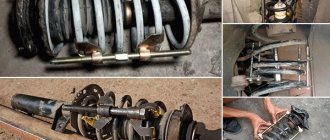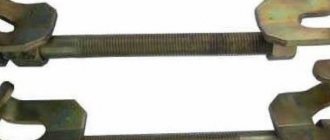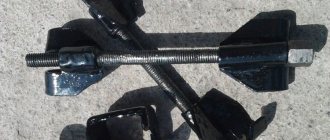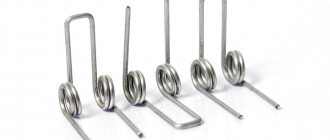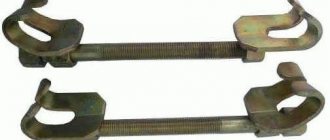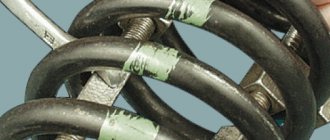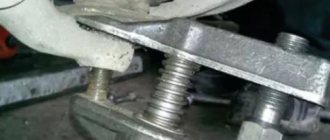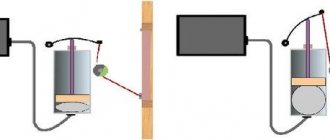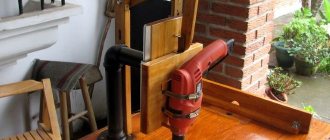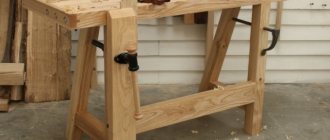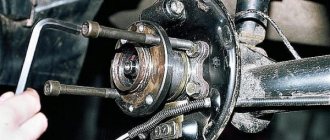The shock absorber is a unit responsible for a comfortable ride. Often the shock absorber strut requires replacement. For example, it leaked or simply exhausted its resource. In this case, the entire assembly is dismantled. The procedure is labor-intensive, but not complicated. You will need a tool such as a shock absorber spring tie. The device is extremely simple, but at the same time necessary when performing such work.
How to make a simple and reliable shock absorber spring remover
We tell you how to make a simple but reliable homemade puller
, with which you can easily and quickly remove springs from shock absorber struts (
compress
and decompress them). Let's look at two different designs that every craftsman can make.
But first, let's look at the main types of these devices. If we talk specifically about factory pullers, there are several types:
Factory models of pullers can always be purchased in the store, but there is not always a reason for this.
For example, if you need to replace a shock absorber strut
or
a spring
1-2 times, it is cheaper to make a homemade design.
You will learn how and what to make a stationary puller for compressing springs
. Thanks to its compact size, it can be installed both on the floor and on a desktop (workbench).
In terms of safety and reliability, a stationary puller is the optimal solution for performing repair work in a garage.
Also in this article we will tell you how to make another simple and inexpensive design - the so-called shock absorber spring tie with your own hands
.
In terms of safety, the screed is inferior to a stationary puller, but if everything is done correctly and normal material is used, then this is also a completely working option.
It’s up to you to decide which device you prefer. Blueprints
in this case they will not be required, since everything is already clear.
What you need to know when dismantling
Tightening car springs is a rather dangerous process. If you make a low-quality puller, it may come off. The high pressure puts you at risk of injury. That is why it is necessary to be extremely careful when performing such work.
To prevent anything from happening, you can make a stationary screed. Its design does not differ from that described above. The only change is the rigid attachment to the tabletop. This will ensure that the shock absorber spring tie is securely fixed, which will significantly reduce the risk of injury. Now let's look at another popular and extremely effective design.
DIY shock absorber spring remover
The first option is a stationary structure, which you can make yourself using a mechanical jack
(can be found on ferrous metal - there are a dime a dozen of them there).
Structurally, a homemade device for tightening shock absorber springs
consists of 4 main elements:
- mechanical jack with extended stand;
- base;
- upper (fixed) fork;
- lower (movable) fork.
In order to be able to use a car jack to disassemble shock absorbers, it will be necessary to lengthen its stand
.
To do this, select a profile pipe of the appropriate size, cut a piece of the required length and weld it to the jack stand. The base of the jack will need to be cut off before doing this.
After extending the stand
— we clean the welded seams with a grinder. We weld the base of the mechanical jack, which was cut off earlier, to the lower part.
Then we weld our entire structure to a more powerful and reliable base, which is the flywheel.
Using a grinder, we cut off the original jack hook, and weld the lower fork in its place. It can be made from pieces of profile pipe.
To make the upper fork we will use a metal plate 7 mm thick. You need to cut a semicircular hole in it to fix the spring
shock absorber
In principle, the lower fork of the puller can also (and even should!) be made from sheet metal to make it more reliable.
At the last stage, all that remains is to clean the welds with a flap wheel and paint the metal. Homemade device
to remove
springs with your own hands
!
We install the shock absorber between the two forks. Unscrew the nut at the top of the shock absorber and remove the support cup.
Then we open the spring with a jack and remove the shock absorber strut.
The detailed process of making the puller, as well as the principle of its operation, can be seen in the video below. The idea of this homemade product belongs to the author of the YouTube channel Glavnyiy Mehanik.
What are the advantages of this design?
The most important advantage is low cost. All the necessary components can be purchased for pennies at a metal receiving station.
Also, the design itself is universal - you can disassemble shock absorbers of different sizes.
DIY shock absorber spring ties
If it is not possible to make a stationary puller, you can make ordinary ties with your own hands.
For this we will need the following materials:
- threaded rod;
- extended couplings;
- round pipe;
- regular hex nuts;
- clamps for fastening ventilation ducts.
The clamps will act as hooks. To make two ties you will need four clamps.
We weld extended couplings to two clamps, and pieces of round metal pipe to the remaining ones.
Cut two pieces of threaded rod to the appropriate length. We screw two nuts onto the end of the studs, and put on bushings made of a round pipe with clamps welded to them.
We screw extended couplings with clamps welded to them onto the top of the studs. As a result, we ended up with a pair of zip ties for disassembling the shock absorbers.
We install the couplers on the spring parallel to each other. After this, we gradually begin to tighten the spring.
Of course, unlike a stationary puller, homemade zip ties take much longer to complete the task. But, as they say: patience and work will grind everything down.
It is important to tighten the ties evenly to avoid distortions. Otherwise, the spring may “shoot”.
In terms of convenience and speed, a stationary puller definitely wins. However, if it is not possible to get a jack, then you can use zip ties.
You can watch the detailed process of making homemade shock absorber spring ties below in the author’s video. The author of the YouTube channel “Samodelkin Uman” shared his experience.
Source
We cook the screeds ourselves
In general, it makes sense to make shock absorber spring ties yourself. How to do this is discussed further.
Four nuts and two threaded rods
The metal products listed below are easy to find in almost any supermarket. For example, you can buy two M16 threaded rods. You will also need four extended nuts, as well as a steel plumbing pipe. Its internal diameter is 16-16.5 mm.
The end result is what is shown in the pictures. You will also need a steel rod, which is used to make reinforcement. Let's look at how screeds are made:
- Two identical cylinders are cut from the pipe, the length of which is 80-120 mm;
- Threaded rods can be shortened if necessary;
- 8 rods approximately 30 cm long are made from reinforcement;
- Using any bending equipment, the rods are bent to obtain hooks;
- Four rods are welded to two nuts, another four - to pipe sections;
- The set of components is completely ready for use at this stage.
It is easier to weld by placing the workpieces on a plane. The essence of these words is illustrated by the picture:
How to weld hook rods
Actually, what follows is a film where the technology is shown “inside and out”. The author even solved the problem with the lack of a bending machine: to bend one rod, you need two similar rods welded to a steel profile.
If the reader thinks that using welding is difficult, then it is better not to take risks. Welded joints can withstand significant loads, but only if they are performed according to all the rules. Spring ties can be made without welding. A suitable drawing is given below.
Two ties in 10 minutes (video)
How should the spring be tightened?
Let's list the steps involved in tightening the shock absorber springs yourself. Everything looks simple:
- When the body is supported by a jack, two ties are brought to the spring from opposite sides;
- By rotating the nuts with your hands, you achieve confident engagement of the hooks and springs;
- Using a wrench, the nuts on different rods are rotated in turn;
- It is better to play it safe and secure the compressed spring with straps or wire.
Video of spring tensioners on shock absorber
No explanation required here. The result is shown in the photo.
When using homemade and even purchased equipment, follow these simple tips:
- Before using ties, threaded connections are lubricated with cyatim or grease;
- The ties cannot be removed from the compressed spring, even if it is additionally fixed;
- When carrying out work, exercise maximum caution. It is better to sacrifice body parts than your own health.
Features of the suspension of Lifan cars are discussed in these articles:
How does a spring remover work, and what types are they?
What is a puller used for? It overcomes the straightening force of the springs. The applied force on the puller brackets is commensurate with the weight of the car, but this does not mean that its design is too expensive and high-tech.
There are many options, but they are divided into only two types: mechanical and hydraulic drive.
Mechanical spring remover
Most often it has a threaded drive mechanism.
With a sufficient diameter of the pin (providing a good gear ratio on the thread), and a long handle of the key, you can compress the springs manually without excessive effort.
The technology is as follows: two pullers are symmetrically put on the rack. By turning the threaded rod, you bring the claws to the middle of the spring directly on the shock absorber, compressing it to the required size.
Drawings of universal threaded ties
Let's return to the question of how to make a device for tightening shock absorber springs yourself. Below is the appearance of the finished devices:
Factory-made threaded ties
On one side of the rod there is a left-hand thread, on the other - a right-hand thread. The standard thread pitch is M18. But buying threaded rods is not enough here. And to cut the thread yourself, you will need special equipment.
Drawings of the components that make up the entire structure are shown here:
Threaded tie (3 parts)
To make parts, you need a lathe, drilling and, probably, milling machine. It may be easier to contact a workshop. Print the drawing by downloading it from the website.
Most likely, there are no other drawings of universal ties on the Internet. And what is shown above is taken from a book on repairing domestic cars. You can use it.
Let's say the ties were made according to the drawings and all the parts fit together. But even then the advice about using lubricant remains valid. You need to take solid oil or cyatim and apply this material to the threads of the nuts.
Cyatim-201 lubricant is a rather expensive material. You can reduce consumption by mixing it with machine oil in a 50/50 ratio. Good luck.
Why do you need such a procedure as tightening the shock absorber springs with your own hands? Due to the current circumstances and because of our vaunted domestic roads, it happens that shock absorber units in a car, even an almost new one, fail. And if they are old enough, they wear out from time of use.
Simple and affordable
We take two rods of equal length. The thread can be any, but it is most convenient to use standard M16 or M18. The rod must have two threads: on one side - left, on the second - right, or vice versa. It is advisable to firmly fix the elongated nut in the center as a limiter. There are such commercial rods, so if there is no special machine for cutting threads, we go to the car market.
All that remains is to weld a few hooks onto the nuts - and you can use them. To make the device work more smoothly, it is advisable to lubricate the thread and nut. You can use regular machine oil or grease. Here it is necessary to achieve smooth operation; almost any lubricant will do. You can also use the drawings and take them to a turner, who will do everything. A shock absorber spring tie is made in a few hours.
Manufacturing instructions
There are many ways to make such a device. Their main idea is to save money and use unnecessary scrap materials to make an instrument. In any automotive market you will be able to find a hydraulic device that is easily used for repairs, but its cost is high for a small device. If you dig around in your garage, you will definitely be able to find things there that seem unnecessary at first glance. Analyze whether they can partially recreate the design you saw on the market. It is unlikely that it will be possible to recreate hydraulic couplers for a shock absorber, but replacing them with a mechanical device is quite possible.
Let's look at a brief instruction on how to make ties for shock absorber springs with your own hands.
- We remove the front wheel shock absorber and measure the size of the large spring that prevents replacement. We start measuring from the first large turn and end with the last one. We write down all the data on a piece of paper, preferably in one unit of measurement (centimeters or millimeters), which is more convenient for you. It is recommended to make clamps specifically for the front wheels, since these shock absorbers most often break and require repair.
- We find a strong metal pipe with a diameter of 2 centimeters in the garage and cut it into 4 pieces 10-15 centimeters long.
- Next, we find a standard rod with a diameter of 0.7-1 centimeters and cut it into pieces 20-30 centimeters long. You should have 8 such short strong rods.
- We find a threaded rod or buy a pipe with a diameter of 1.5-1.7 centimeters and cut it into 2 pieces, the length equal to the measurement obtained in the 1st point, which can be extended to 5 centimeters. If the selected tubes do not have threads, we cut them using a special tool from all edges of each piece over 10-15 centimeters.
- We process all the edges of the tubes and rods in such a way as to get rid of metal burrs; the edges should be even and smooth.
- We bend the metal rods equally so that they form a hook on one side. Please note that such rods are very strong and difficult to bend, so you can use additional tools.
- Using mobile welding, we connect the rods and short tubes so that the hooks are evenly located on both sides of the tube. We cut off the excess edges of the rods so that they are flush with the tube. We get 4 small products from rods and pipes.
- We put the resulting parts on long tubes and tighten large nuts at the ends. The hook is put on so that its smooth side faces the edge of the bar.
- That's all the work, the shock absorber tie is ready. It will fit both the front wheel and the rear (if you added a few extra centimeters to the bar). Test it on one of the shock absorbers and correct any shortcomings if any appear.
This technique allows you to quickly build a mechanical device that can compress or slightly expand the shock absorber spring to repair, replace or check it. The only disadvantage of this method is that the master must be able to use mobile welding. If such a device is not available or you do not want to use it, then you can build a similar device without using a complex mechanism. The method of producing shock absorber ties based on an old strong jack is considered very good .
If you remember, such devices were included with old Soviet-era car models. Its operation scheme is clear; all that remains is to make sure that one part of the jack can be attached to the upper coil of the shock absorber spring, and the other branch to the lower one. This can be done through various means - look at what is present in your garage among the parts and be sure to find something suitable. Keep in mind that the above methods for producing screeds are not the only ones of their kind; they can be changed or supplemented depending on the type of car, its model, skills and desires of the car owner. It’s worth using your imagination to make this mechanism simple and uncomplicated.
Communities › Garage Equipment and Tools › Blog › DIY spring ties
Hi all. I'm twisting the suspension in places. And you have to change the springs, but this is a rather unsafe task, it can fly into your head and leave you without a finger. But it needs to be done)). And in order to make my work easier, I decided to sculpt a machine for compressing and releasing springs from a Volgov jack (I spotted it on the internet). But after half a day of welding, I realized that mostly in YouTube they compress small springs, which I can easily compress with ordinary ties. Yes, and the plates must be even, otherwise everything will compress awry, and to add to this, my jack was already rickety and did not want to work as expected. What do I mean by all this? And to the fact that after I went PSYCHANIC, I cut up the entire halabuda, and made excellent couplers from the screws of the worthless jacks that would not let me down. And I also rebuilt the factory ones and now they are quite reliable and convenient. What actually happened: Here is a tie from an old non-working jack for Renault 19. The jack is bent, but the screw is reliable. But I made one very necessary upgrade to this device. I added a support bearing to it (the red one in the photo) that was in the jack. That is, if earlier (tested) when you twist the nut, it could bite due to friction, the tie could be pulled to the side and it would naturally fly off, THEN now the support bearing will not allow this to happen, everything will spin like clockwork and the tie will stand dead. The grips are made from a thick chain link, they will never straighten out)))
Communities › Do It Yourself › Blog › Strut Spring Tie
After replacing the struts all around for my son and the front struts for my son-in-law, I realized that zip ties are no good at this age
compress the springs (the springs are still original, the struts are leaking). A trip to the ferrous metal. It looks like an unfinished grill.
Hmmm. when there is nothing to do why not...
done perfectly! but I think for myself this one is easier and faster!
Everyone goes their own way. I went mine. And I wish you to get there and receive satisfaction from what you have done!
Engineering thought never sleeps! But is the manufacture of such equipment justified for non-permanent work? It’s okay if the springs need to be compressed 5 days a week from 8 a.m. to 5 p.m., or even in 2 shifts. Although, from the point of view of self-improvement, it’s very good!
Once upon a time, when you were still on a penny, you had to take out the engine. I took it out with a neighbor, moved it on the wheel and installed it myself. Because I made a crane for unloading, then a tilter. And I no longer experience problems with this on subsequent machines. I think it’s better to have a tool when you don’t need it than not to have it when you needed it yesterday.
Engineering thought never sleeps! But is the manufacture of such equipment justified for non-permanent work? It’s okay if the springs need to be compressed 5 days a week from 8 a.m. to 5 p.m., or even in 2 shifts. Although, from the point of view of self-improvement, it’s very good!
“Is the manufacture of such equipment justified for non-permanent work?” Every garage has a hammer and chisel, 99% of garages have a drill, 70% have a semiautomatic welding machine, 50% have a compressor. And at best, only ten percent of all those who have this tool use it every day! The rest simply have it and money was spent on this instrument.
Spring tightening process
Let's start with the fact that the pullers described above are not the only ones of their kind; there are several other configurations of this device; you can also make it yourself or simply buy it. However, without it, the screed will be a complete nightmare and an almost impossible task.
When starting to perform this operation, it is necessary, first of all, to remove the strut with the shock absorber, having first placed the car on a jack and securely fixed it.
Next, the puller is attached to the upper and lower coils of the springs, and manual work begins. Depending on the operating principle of your puller, you will either rotate some element of it, or, as in the case of the “frog,” alternately work with two pedals.
At this point, the tie can be considered complete; the main thing to remember is that you should not compress the spring completely, increasing the risk of breakage of both the spring itself and the compression device. It is enough to simply release the element you need from the pressure and repair or replace the shock-absorbing mechanism.
As for the use of a puller, it is designed to facilitate the entire repair process, because without it you would not only have to fix the stand with a vice, but also make enormous efforts to compress the springs; someone would need to hold them while you work on the entire mechanism etc.
In addition, by using this device, you make the repair process safe for yourself, practically eliminating the chance of spring failure.
Spring ties: an easy way to replace springs in shock absorbers
The suspension of most cars has shock absorbers and springs (often combined into one unit), and periodically there is a need to replace these elements. Particularly difficult (and dangerous!) is replacing springs that are in a compressed state - spring ties, which you will learn about in this article, are especially used for this purpose.
This article continues the series of publications about a special tool.
What is a spring tie?
The chassis of the vast majority of modern passenger cars (as well as trucks and agricultural machinery) contains elastic and damping elements - springs and shock absorbers. In some types of suspensions (including suspensions built according to the most popular MacPherson strut pattern in our time), the shock absorber and spring are combined into one unit - a shock absorber strut.
Regardless of where the spring is installed, it is always in a compressed state - this ensures the necessary suspension characteristics and minimizes body vibrations. This circumstance creates serious difficulties when replacing a spring, because a compressed spring is extremely difficult to remove, and a new spring must be tightened before installation. The operation of replacing springs is not only difficult, but also dangerous - a compressed spring, due to the accumulated energy, can cause serious injuries and material damage.
A special tool - a spring tie - can significantly simplify and secure the procedure for replacing springs. This tool makes it possible to replace springs and struts alone, safely and with minimal time.
- 1 490 ₽
- 1 710 ₽
- 1 650 ₽
- 2 950 ₽
- 1 080 ₽
- 2 560 ₽
- 1 610 ₽
- 1 690 ₽
Design and principle of operation of spring ties
To tighten the spring, you need to apply force to its outer turns; this can be done in two different ways: using a simple threaded connection (this is how screw jacks are designed, which were already written about earlier) or using a hydraulic cylinder. This is the principle that underlies all spring tensioning devices.
The simplest tie contains only three parts: a threaded rod and two stops (or grips) for the spring, and in one of the stops a thread is cut or a nut is inserted - when the rod is tightened, this stop moves to a fixed stop and compresses the spring. Instead of a threaded rod, a more complex system can be used (the rod is hidden inside the cylinder, the cylinder itself can be telescopic, etc.) or a hydraulic cylinder (mostly professional portable and stationary couplers have such a device).
Types and types of spring ties
All devices for tightening springs can be divided into two large classes:
- Stationary (used in car service workshops);
- Portable (simple devices for use by ordinary car owners).
Regardless of the type, all couplers can be divided into two types according to the method of fixing the spring:
- Central couplers (a threaded rod or hydraulic cylinder in the operating position passes through the center of the spring, the spring is held by cup- or disc-shaped grips);
- Ties for MacPherson-type suspensions and the like (the threaded rod or hydraulic cylinder in the working position is located outside the spring, the spring grips are made in the form of hooks or are C-shaped and work like consoles).
The central coupler is only applicable to working with springs in traditional suspension designs, in which the spring is located separately from the shock absorber. Ties for MacPherson-type suspensions are used to work with springs combined with shock absorbers - in this case, it is not possible to position the rod inside the spring, so the grip is carried out from the side.
Finally, spring ties can have different drives:
- Mechanical is just a threaded rod;
- Hydraulic - the tie is made using a hydraulic cylinder with a force of up to 1-2 tons (this tool is used to tie powerful springs of cargo and agricultural equipment).
Spring Tie Kits
Now there are many types of spring ties on the market, among which you can choose from very simple options for several hundred rubles, as well as more serious tools, including universal sets. Typically, such a set contains one working cylinder (mechanical or hydraulic), two or three sets of clamps for springs of different diameters (disc or C-shaped) and additional accessories to expand the functions of the tool.
Kits often include an adapter for working with conical springs (it allows you to use a smaller grip, aligning its center with the center of a large grip).
However, most kits do not come with an important tool that a car owner should have - a wrench or wrench. The threaded rod of the tie has at one end either a hexagon for working with a wrench, or a square-section recess for a wrench used for working with socket heads.
Spring tie kits come with a higher price tag, but they pay for it in increased performance, convenience, and safety.
How to make a shock absorber spring remover with your own hands
Dear visitors to the “ Samadekin Friend ” website, today we will look at one of the options for making a homemade shock absorber spring puller with our own hands, as well as look at step-by-step photos of assembling the spring puller and a video. Every car enthusiast who has ever repaired the suspension of a passenger car knows perfectly well how difficult it is The shock absorber springs are removed and to perform this operation without a special tool you will have to get pretty clever. But if you think a little and use ingenuity, then a simple shock-absorbing spring remover can be made independently and at minimal cost, so to speak, a simple and budget version of a tool that makes life easier for a motorist.
The design and principle of operation of the presented puller is actually quite simple and understandable; it is based on the compressive force of the spring's screw tie, namely, there are 2 metal hooks installed on the pin that hook onto the spring and, under the influence of tightening the nut, the spring is compressed and then removed from the rack.
So, let's look at what exactly is needed to assemble the puller.
- metal pipe 16-20 mm
- hairpin M-14
- corner
- nut 2 pcs
- solid oil
Tools
- welding inverter
- drill
- vice
- hammer
- wrench
- Angle grinder (grinder)
Step-by-step instructions for creating a shock absorber spring remover with your own hands.
A few more points
So we have figured out that making a screed with your own hands is not so difficult. For this, apart from desire, a small amount of tools and time, you don’t need anything. If there is no tie, but the spring needs to be removed, then it is better not to risk your own health and not to experiment, but to contact a service station.
It will not be possible to tighten the shock absorber spring without zip ties; this has already been said. This does not apply to cases where the product has lost its elasticity and has cracks. Such a spring can no longer be called working. You can find a huge number of options for making homemade zip ties, the most popular of which we have just reviewed.
A homemade shock absorber spring tie is quick and easy to make. The main thing is that the structure is durable and fulfills its main task. Don't forget that if the tie comes off the spring, you can get seriously injured from the impact, so always try to keep the spring away from your face and securely fasten it if possible.
Manufacturing a shock absorber spring remover
Many car enthusiasts use a regular chain: they wind a few turns around the coils of the spring and tighten the chain. After lifting the car with a jack, the shock absorber strut is stretched, but the spring remains compressed. This is a dangerous method: if the chain slips, the spring may spring back and cause serious injury.
How to make a simple puller similar to an industrial one
A mechanical semi-stationary “machine” can be created from a “Volgovsky” jack.
- old jack from Volga-24, Moskvich 412 or other Soviet passenger car = 0 rub.
- old connecting rod from any engine = 0 rub.
- steel corner from a landfill 1 meter = 0 rub.
- a pair of rods from broken shock absorbers = 0 rub.
- a handful of bolts and nuts M12 - M14 = conditionally free.
Making a tie for shock absorber springs with your own hands
Using a grinder, we cut two meter-long pieces from a pre-prepared pipe. We adjust the threaded rods to the required length. Next, we take the reinforcement and mark eight 30 cm sections. We saw it using a grinder and using any bending equipment we try to make hooks from the rod.
Please note that you will also need a welding machine. If you don’t have your own, you can borrow it from a neighbor for a while. We weld 4 pre-cut rods to the nuts, the remaining 4 to the pipe. In principle, we made ties for the shock absorber springs with our own hands and can use them. Let's look at a few more interesting options that are popular among car enthusiasts.
Required material and tools
To make a screed yourself, you will need a metal rod (reinforcement), two threaded rods (M16), as well as extended nuts and a metal tube with an internal diameter of 16 mm. This will be quite enough to make a full-fledged screed.
It is also advisable to have a grinder on hand for cutting reinforcement and several wrenches for the nuts. The set of tools is minimal; all this can be found in the garage of any motorist. Well, now let's take a closer look at the process of assembling the product.
Homemade spring removers from car struts - video
Homemade portable stand
Bottom line: The cost of homemade spring pullers tends to zero, since they are literally assembled from trash. And without them, it is not possible to service the car’s suspension.
- DIY shock absorber spring tensioner
- Spring tensioning equipment
- How to make a screed device yourself
- Necessary tool
- Manufacturing process
- How to tighten a spring correctly
If you need to repair shock absorber struts or car suspension, the question arises of how to tighten the shock absorber spring. To achieve this goal, spring ties are used. They are necessary in order to compress and remove any type of spring.
Spring tensioning equipment
Spring ties can be of two types, depending on the basic principle of operation:
• Mechanical – based on mechanical action on a spring. Their price is low, and they are often used by car enthusiasts.
•Hydraulic – the action on the spring is created using a hydraulic pump. Used in large car repair shops. The price is much higher.
Auto repair shops usually buy compressors with a wide range of possible sizes, since they are used on different cars. If you have not given up the idea of repairing your vehicle yourself, then you need to pay attention to the fact that some models of couplers are offered by the manufacturer specifically for certain types of suspensions. But they can also be universal.
How to make a screed device yourself
If you calculate the price of the components of a spring puller, it will be significantly lower than the price of a finished puller. Therefore, the question arises: how to make a spring puller with your own hands. It is possible to make spring ties yourself. But at the same time you need to have a welding machine and the ability to make something with your own hands.
It is clear that the principle of their operation will be based on the mechanical effect on the spring. For one spring, two ties are required, secured on opposite sides for uniform compression. Their design is standard: a threaded rod with hooks and nuts. By turning the rod or nuts with a wrench, we can easily compress the spring. Since the design is simple, it does not require special skills in manufacturing. But you should remember that the device you make must be reliable, since now you are responsible for your own health.
Cost of ties in stores
You don’t have to bother at all and buy the finished product in the store. Abundance can be confusing. There are hydraulic and mechanical shock absorber spring tensioners. The price for them differs significantly. The cheapest options will cost about 1,500 rubles, and the most expensive - about 30,000 thousand. Of course, for single jobs it is not at all necessary to purchase an expensive product. A mechanical coupler for a couple of thousand rubles will be enough for you.
You can purchase hydraulic couplers. It’s more convenient to work with them, but the price tag is twice as high. There are universal zip ties with various attachments, but this is also a fairly significant purchase. Pay attention to high-quality mechanical shock absorber spring tensioners. The price for a normal product will be in the range of 2-3 thousand rubles.
Shock absorber spring clamp from a jack
There is also an alternative option that does not require special preparation or a large number of tools. To make it, we will need a grinder, a connecting rod from a classic, as well as an old jack from a VAZ (original). The procedure is as follows.
Using a grinder, we cut off the lower support on the jack, as well as the rivets. Next, in the place of the lever for raising/lowering the jack, we mount two ears for the bolts using welding. In the place where the rivets were removed, we weld a piece of pipe measuring 25x25, we do the same in the place of the welded ears, only we take a 20x20 pipe. You can further strengthen the jack with another piece of pipe, cut to the required length. In general, this device for tightening shock absorber springs is quite effective, and it can be made quite quickly without much expense.
Homemade spring ties with your own hands
Homemade spring ties with your own hands
Shock absorber spring tensioner
=== Download file ===
The shock absorber is a unit responsible for a comfortable ride. Often the shock absorber strut requires replacement. For example, it leaked or simply exhausted its resource. In this case, the entire assembly is dismantled. The procedure is labor-intensive, but not complicated. You will need a tool such as a shock absorber spring tie. The device is extremely simple, but at the same time necessary when performing such work. Despite the fact that the design of the screed is extremely simple, they come in several types. For example, dealers of some companies use branded tools that are suitable only for a certain brand of car. This also applies to screeds, although in most cases such scrupulousness is not required. Universal screeds, as the name suggests, are suitable for everything. A spring is a spring everywhere, and the device for working with it is suitable for any make of car. As for the craftsmen who repair cars in their garage, they need a screed. Let's see how to assemble such a tool with your own hands. To make the screed yourself, you will need a metal rod reinforcement, two M16 threaded rods, as well as extended nuts and a metal tube with an internal diameter of 16 mm. This will be quite enough to make a full-fledged screed. It is also advisable to have a grinder on hand for cutting reinforcement and several wrenches for the nuts. The set of tools is minimal; all this can be found in the garage of any motorist. Well, now let's take a closer look at the process of assembling the product. Using a grinder, we cut two meter-long pieces from a pre-prepared pipe. We adjust the threaded rods to the required length. Next, we take the reinforcement and mark eight 30 cm sections. We saw it using a grinder and using any bending equipment we try to make hooks from the rod. Please note that you will also need a welding machine. If you don’t have your own, you can borrow it from a neighbor for a while. We weld 4 pre-cut rods to the nuts, the remaining 4 to the pipe. In principle, we made ties for the shock absorber springs with our own hands and can use them. Let's look at a few more interesting options that are popular among car enthusiasts. There is also an alternative option that does not require special preparation or a large number of tools. To make it, we will need an angle grinder, a connecting rod from a classic, as well as an old jack from a VAZ original. The procedure is as follows. Using a grinder, we cut off the lower support on the jack, as well as the rivets. In the place where the rivets were removed, we weld a piece of pipe measuring 25x25, we do the same in the place of the welded ears, only we take a 20x pipe. You can further strengthen the jack with the help of another piece of pipe, cut to the required length. In general, this device for tightening shock absorber springs is quite effective, and it can be made quite quickly without much expense. Tightening car springs is a rather dangerous process. If you make a low-quality puller, it may come off. The high pressure puts you at risk of injury. That is why it is necessary to be extremely careful when performing such work. To prevent anything from happening, you can make a stationary screed. Its design does not differ from that described above. The only change is the rigid attachment to the tabletop. This will ensure that the shock absorber spring tie is securely fixed, which will significantly reduce the risk of injury. Now let's look at another popular and extremely effective design. We take two rods of equal length. The thread can be any, but it is most convenient to use standard M16 or M. The rod must have two threads: It is advisable to firmly fix an elongated nut in the center as a limiter. There are such commercial rods, so if there is no special machine for cutting threads, we go to the car market. All that remains is to weld a few hooks onto the nuts - and you can use them. To make the device work more smoothly, it is advisable to lubricate the thread and nut. You can use regular machine oil or grease. Here it is necessary to achieve smooth operation; almost any lubricant will do. You can also use the drawings and take them to a turner, who will do everything. A shock absorber spring tie is made in a few hours. You don’t have to bother at all and buy the finished product in the store. Abundance can be confusing. There are hydraulic and mechanical shock absorber spring tensioners. The price for them differs significantly. The cheapest options will cost about 1 ruble, and the most expensive - about 30 thousand. Of course, for single jobs it is not at all necessary to purchase an expensive product. A mechanical coupler for a couple of thousand rubles will be enough for you. You can purchase hydraulic couplers. It’s more convenient to work with them, but the price tag is twice as high. There are universal zip ties with various attachments, but this is also a fairly significant purchase. Pay attention to high-quality mechanical shock absorber spring tensioners. The price for a normal product will be in the range of thousands of rubles. So we have figured out that making a screed with your own hands is not so difficult. For this, apart from desire, a small amount of tools and time, you don’t need anything. If there is no tie, but the spring needs to be removed, then it is better not to risk your own health and not to experiment, but to contact a service station. It will not be possible to tighten the shock absorber spring without zip ties; this has already been said. This does not apply to cases where the product has lost its elasticity and has cracks. Such a spring can no longer be called working. You can find a huge number of options for making homemade zip ties, the most popular of which we have just reviewed. A homemade shock absorber spring tie is quick and easy to make. The main thing is that the structure is durable and fulfills its main task. Don't forget that if the tie comes off the spring, you can get seriously injured from the impact, so always try to keep the spring away from your face and securely fasten it if possible. Life Economy Science Auto Leisure High-tech Health. These 18 foods will help you fight cravings. Why a woman smells unpleasant: A charming photo shoot of a mother of quintuplets. Why do women experience orgasm? Why can't you put periods in SMS messages? Fun facts about sex you should know. Why can't you hug cats? What does it mean if a dog licks you? Why are these exercises a waste of time and effort? Home Home comfort Do it yourself Tie for shock absorber springs with your own hands: Subscribe Share Tell Recommend. Universal and branded Despite the fact that the design of the screed is extremely simple, they come in several types. Subscribe Share Share Recommend. Pay attention to your body. What does your nose shape say about your personality? Many experts believe that you can tell a lot about a person's personality by looking at their nose. Therefore, at the first meeting, pay attention to the nose of a stranger. You are unlikely to be able to surprise or shock someone if you admit these 10 little things a man always notices in a woman. Do you think your man knows nothing about female psychology? Not a single little thing can be hidden from the gaze of a partner who loves you. And here are the 10 things Top Broke Stars It turns out that sometimes even the biggest fame ends in failure, as is the case with these celebrities. Why are some children born with an 'angel's kiss'? Angels, as we all know, are kind to people and their health. If your child has the so-called angel's kiss, then you have nothing to do
Source
Universal and branded
Despite the fact that the design of the screed is extremely simple, they come in several types. For example, dealers of some companies use branded tools that are suitable only for a certain brand of car. This also applies to screeds, although in most cases such scrupulousness is not required.
Universal screeds, as the name suggests, are suitable for everything. A spring is a spring everywhere, and the device for working with it is suitable for any make of car. As for the craftsmen who repair cars in their garage, they need a screed. Let's see how to assemble such a tool with your own hands.
